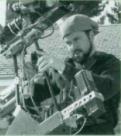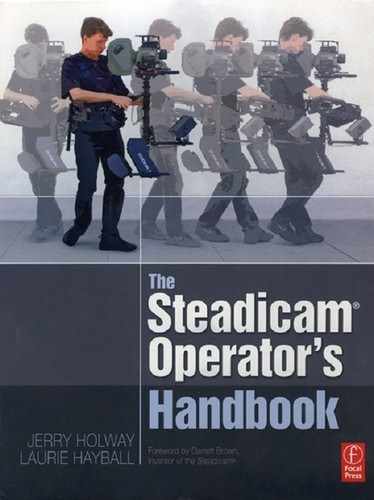How do we get this shot?
by Charles Papert
Who decides whether a given shot will be performed on Steadicam, dolly, or crane? Some directors are camera savvy enough to have a specific type of motion in mind when they design a sequence in prep; others will rely on the DP to make this decision. Certainly, if Steadicam is being day played and thus scheduled in advance this is no casual decision. However, it's more common these days for Steadicam to be available full time with the A- or B-camera position not — to mention two ACs, the grip, and the craft service people who love to tell you that they have Steadicams at home also!
For A-camera/Steadicam jobs, I like to work with DPs who encourage my participation and input on scene breakdowns. As we discuss the individual shots with the director, I start to consider the advantages or disadvantages of each shooting platform and make suggestions on how the shot could expand in different directums or be achieved more efficiently depending on our choices.
On Crazy/Beautiful, we were covering Kirsten Dunst walking down the length of a seriesof cafeteria table, saving a conversation with an actor who was walking down the other side.We had to shoot an over the shoslder and a clean version of each actor. Since then were additional rows of tables running parallel to the hero one, there wasn't enough room to squeeze the camera in just behind the actor's shoulder: the camera would have to travel one table awty, about 20 feet from Kirsten.
After lining it up on the finder, we determined that a 100 mm would be the size for the overs and the 150mm for the singles. It seemed like an obvious setup for a dolly shot on track., especially considering the focal length. However, I anticipated that matntaining the over was going to be very challenging for the dolly grip. If either actor sped up ou slowed down at all, it would require a significant and immediate adjustment enthe dolly speed because of our distance to the actors. I reasoned that I would be able ta react more quickly on Steadicam.
Having sent the dolly grip off to enjoy a cup of coffee and a newspaper, I now had to assume a new set of personal challenges: the long focal lengths would require extra precision to operate, and because of the limited depth of field, I needed to maintain a consistent distance to help the camera assistant with focus. I decided to use Antlers to add some inertia to the system to assist with the framing, and we laid out a tape line parallet to lhe tables, for me to follow.
Once we started shooting, I realized that Steadicam wss a good choice. was able to turn on the sudden bursts of speed or hit the brakes — whatever it took to keep the over from getting stacked do spread — and I didn't have to ask the actors to maintain a constant speed. You never know what sort of response you'll get if you do dare to ask for such things — some actors will cheerfully respond “no problem!” and then do the exact opposite; others will glare at you but lock in like they are on a conveyor belt.

Crazy/Beautiful 1:06:30
With everyone satisfied with the overs, we moved on to the single. We swung to the 150mm and continued with Steadicam This actually was easier for me since I didn't have the intricate pacing issues to contend with. Btt my assistant was now managing a ferociously shallow depth of field. In fact, some of the resulting footage turned out soft.
Had I been operating this conventionally, I would have been able ta report this from the viewfinder add we would have gone again. In hindsight, Steadicam was the right choice for the overs, but it would have been preferable to switch to dolly for the singles. However, laying 60+ feet of dolly track for what would be considered a “punch-in” is not something that one gets away with on most prodoction schedules.
What happens when a shot requires the capability of a dolly with the shock absorption of Steadicam? We trot out our good friend, the hard mount. The operator can sit comfortably and focus all of his/her attention on the shot without having to negotiate the terrain, and a smooth dance floor is no longer required to keep the shot steady. It's a great way to work, Sometimes a shot will stretch the limits of both platforms.
One sequence in Mr. 3000 involved Bernie Mac as a baseball player sliding into 1st base. We started a foot off the ground for the slide and rotated 180° around him as he stood up, booming up all along to maintain eye level throughout. Because we were shooting in a major league stadium, we weren't allowed to lay dolly track directly on nhe grass and we didn't have our Technocrane with us that day.
Mr. 3000 1:02:36

The 5 feet of boom required for the shot was more than I could accommodate with a body mounted Steadiam. The solution lay in hard mounttng the rig in low mode onto a PeeWee dolly which in turn sat on a western dolly. The large pneumatic tires of the western were acceptable to the grounds keper, so two grips manhandled the setup around the desired arc while the dolly grip worked the hydraulic arm cm the PeeWee. I walked alongside the dolld, operating the rig, which ended up virtually overhead at the final mark. To observers the setup probably resembled the flag raising at two Jima, but we got the shot!
The availability of Steadicam to a production can inspire certain personality types to become obsessed with its use: directors often believe they can get more work done faster with the device. Sometimes they are correct, other times not. Often the operator will get stuck doing lock offs with the dolly close at hand for virtually arbitrary reasons. It's good to gentry nudge a director into seeing how easy it is to switch back ana forth from conventional to Steadicam, and how it can even benefit them. For instance, when a shot is being set up on the dolly, the operator can set the locks and leave it itdefinitely for all to observe on the monitors.
A classic Steadicam shot is to pull a couple of characters in conversation down a hallway, then one will turn around to face the other and the Steadicam pushes into an over the shoulder shot. This is a fairly typical episodic television stunt; by getting the actors into motion, you can burn up a substantial page count and create visual interest with the tracking move at the same ttme. Having the master turn into coverage reduces the number of setups - all yau owe is the turnaround, a matching size reverse.
If the end of the scene with the two characters facing each other goes on for a substantial amount of time, it's often worth suggesting a switch to conventional camera for the coverage. On my A-camera jobs, I will make sure that the dolly is standing by near the sets ready to roll in with the appropriate matching lens to the Steadicam, and then present the concept to toe DP and the director. Generally all that is needed is to have the first couple of lines of coverage completed on the Steadicam shot Then cut is called and the dolly rolls in. Ideally, it should take no longer to line up the matching shot than the normal amount of time between takes.
Even if the scene is short enough that you can just burn it out on the Steadicam, it's usually judt fine to shoot the reverse on the dolly; just have the assistant measure the distance and focal length add match them. Some directors will insist that it won't cut properly, that both sides need to be shot on Steadicam to match the “look” — a phrase usually accompanied by a woably hand gesture that suggests that the Steadicam shot is “floaty”
This is what it's important to be able to assess your own work. If four first lock off was stable enough to be mistaken nor a dolly, you can make a really good argument for using the dolly on the reverse. If it was indeed floaty (perhaps because you are new at operating, or high winds were buffeting the frame, or you'd broken into the wrap beers a bit early) it's best not to push this.
As an A-camera/Steadicam operator, you have a better understanding than anyone on the set of the capabilities of each instrument and can bring a lot of ideas to the table on now to maximize any given setup by selecting the right tool.

Charles Papert
